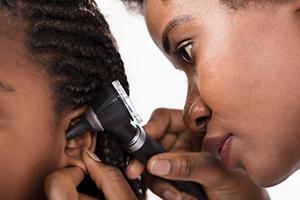
June 30, 2021
The quest to better understand otitis media (OM) has made great strides in recent years. Researchers—many supported by the NIDCD—have identified potential vaccine candidates, uncovered the role of bacterial biofilms in treatment resistance, developed OM animal models, and characterized the host immune response to the condition, among many other advances. To accelerate the translation of this strong foundational knowledge to clinical strategies for preventing and treating OM, last autumn the NIDCD convened a group of scientific experts online for the NIDCD Workshop on Otitis Media in Early Childhood. This message will give you a sense of the topics the participants discussed and the knowledge gaps they identified. I’ve also included highlights from the May meeting of the National Deafness and Other Communication Disorders (NDCD) Advisory Council Meeting.
NIDCD Workshop on Otitis Media in Early Childhood
Otitis media—commonly known as ear infections—represents a substantial disease burden in the U.S and globally, especially in underserved populations. In the U.S., OM is the most common childhood illness, with more than 90% of children having an episode by age 5, and roughly 15% experiencing one of the more serious forms, such as recurrent or chronic OM. The impact of recurring or chronic OM on a child’s development can be significant, leading in some cases to hearing loss and to deficits in speech, language acquisition, learning, and complex auditory processing.
Given the ubiquity and importance of this public health issue, the NIDCD convened a workshop on October 8, 2020, to discuss OM in early childhood, with an objective of identifying scientific strategies for catalyzing the transition of basic science discoveries to prevention and therapies.
The workshop panel was composed of 14 scientific experts and was chaired by Allen F. Ryan, Ph.D., of the University of California, San Diego, a longtime NIDCD grantee in the field of OM and a former advisory council member. The panel included basic and clinical scientists with expertise spanning a wide array of disciplines related to OM, such as biofilms, inflammation, therapeutics, and microbiology. I extend my appreciation to the panel members for their gracious participation, thoughtful work, and valuable input.
The panel was charged with reflecting upon the following broad topics and identifying knowledge gaps that should be addressed in the future:
- Otitis media: past, present, and future
- Epidemiology/public health/disease burden
- Research barriers, successes, and translation
- State of treatment/prevention
- Developmental impact of OM and lifetime sequelae
- Workforce pipeline and training
Subpanels for each area met periodically in the months leading up to the workshop. At the workshop, each subgroup shared its report with the full panel, with the deliberations leading to refinements of the final report. The workshop summary documents the outcome of these discussions, highlighting the current state of the science, research needs, and the panelists’ recommendations for research strategies to address major knowledge gaps.
NIDCD scientific program staff will carefully consider the workshop panel’s recommendations and identify strategies that have the greatest potential to advance OM research and lead to more effective prevention and treatment approaches.
I hope that the workshop will help raise awareness of the impact of this serious and common condition, attract trainees and established scientists alike to the field, and inspire innovative new approaches to future OM research studies. For more information on NIDCD-funded research on OM, please contact the workshop organizer, Bracie Watson, Ph.D., who is the program director at the NIDCD for OM.
National Deafness and Other Communication Disorders Advisory Council Meeting, May 20-21
On May 20-21, the institute’s advisory council convened virtually. I invite you to watch the archived videocasts of open portions of the meeting (May 20 and May 21) and to join us online for our next meeting, to be held virtually on September 9-10. Here are a few highlights from May’s meeting:
- Alberto Rivera-Rentas, Ph.D., an extramural research training officer in the NIDCD Division of Scientific Programs, reported on new research training programs and initiatives at the institute. He described the development of new programs, created using the R25 mechanism, aimed at engaging clinician-scientists and people of diverse backgrounds in biomedical research careers in NIDCD mission areas. To view this presentation, start at the 20 minute mark in the May 20 videocast.
- Bracie Watson, Ph.D., an NIDCD program director in the Division of Scientific Programs, briefed the council on the NIDCD Workshop on Otitis Media in Early Childhood, which I described above. To view this presentation, start at the 44 minute mark in the May 20 videocast.
- Allen F. Ryan, Ph.D., of the University of California, San Diego, provided an overview of OM and shared his research group’s work on the pathophysiology of the condition and on potential treatments. To view this presentation, start at the 55 minute mark in the May 20 videocast.
- Craig Jordan, Ph.D., director of the Division of Extramural Activities at the NIDCD, will retire in August after 37 years at the NIH. NIDCD Deputy Director Judith A. Cooper, Ph.D., recognized his outstanding service to the institute, noting his unwavering support for his staff, his commitment to community outreach, his numerous awards, including an NIH Director’s Award, and his key role as executive secretary to the advisory council. To view this presentation, start at the 10 minute mark in the May 21 videocast.
- The co-chairs of the council’s Working Group on Diversity and Inclusiveness, Lisa A. Goffman, Ph.D., of the University of Texas, Dallas, and Fan-Gang Zeng, Ph.D., of the University of California, Irvine, shared a summary of the group’s work, focusing on identified needs and proposed solutions. The working group identified increasing funding, diversifying the workforce, enhancing mentoring opportunities, building the workforce pipeline, and raising awareness of the NIDCD’s commitment to diversity and inclusiveness as critical needs, and proposed a number of creative solutions. To view this presentation, start at the 36 minute mark in the May 21 videocast.


